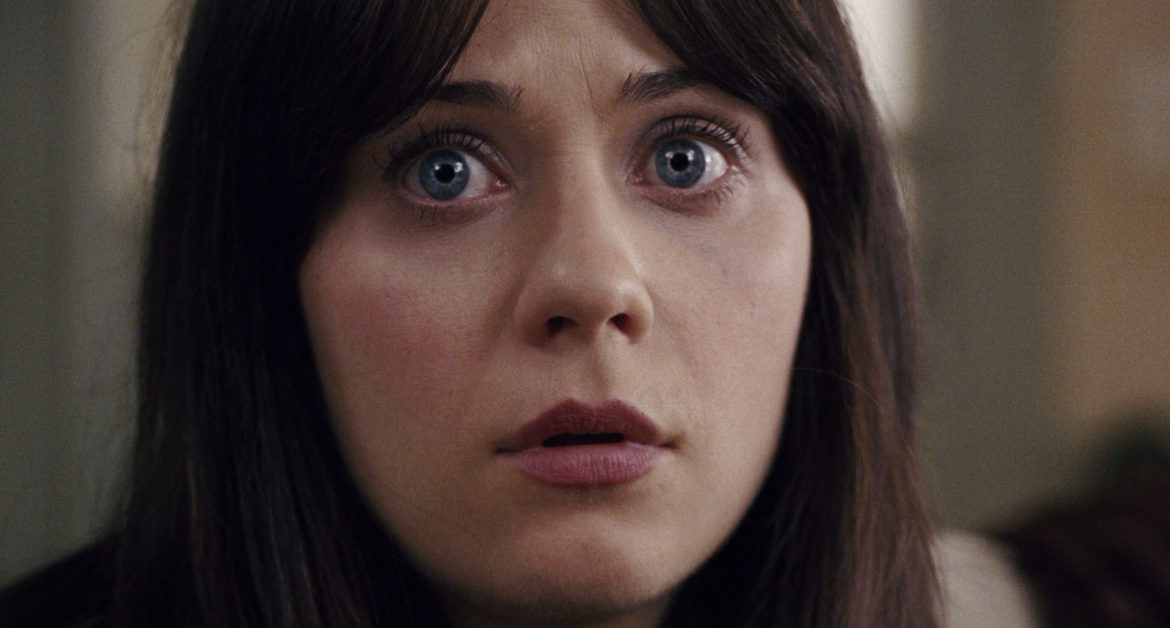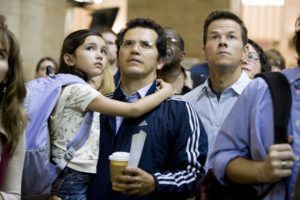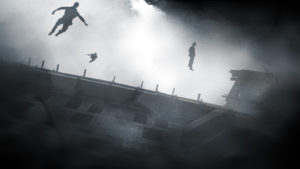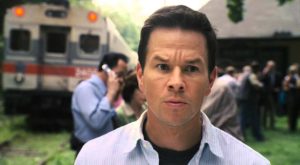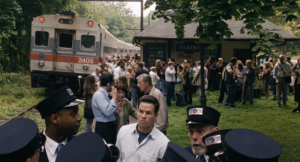I tried several times to conjure up a proper review, but the film itself is so fragmented and bizarre that a standard write-up would fail it.
Instead, I present to you: 46 things that happen in The Happening, and a handful of related critiques.
- The Happening is the story of a global event in which the plants fight back, releasing neurotoxins (maybe) that induce humans to kill themselves.
- When the first of several construction workers plummets to his death, his colleague notes, “Christ, McKenzie fell.” We never meet any of these characters again.
- The Happening is also the story of a rocky marriage between Elliott (Mark Wahlberg) and Alma (Zooey Deschanel), though it’s never really clear Wahlberg realizes this. Elliot teaches science. Alma has enormous eyes. Neither talk like humans.
- The Happening is also the story of science itself being inexplicable, including to high school science teachers.
- The Happening sometimes seems to be a story about parenthood and responsibility, and being caught in transit, and train conductors who abandon trains without explanation, unless high school science teachers ask.
- We move from place to place, house to house, and each are fraught with, I suppose, meaning. But none of the pieces fit, to the extent that the entire film becomes a study in contrasts. Inscrutable contrasts.
- We open on ominous clouds as the titles roll, and immediately encounter a curiously specific time stamp: “8:33 a.m.” Women are talking on a bench, seemingly enjoying a leisurely morning in the park. One of them begins repeating phrases, and promptly stabs herself in the throat with the world’s sharpest hairpin. Do people wear hairpins that are indistinguishable from knives? This is, perhaps, another thing science will never properly explain.
- As the film progresses, we begin to suspect that parks are integrally related to the epidemic of mass suicide. Oh, did I say we suspect it? No, we are repeatedly told so. In one of my favorite scenes, everything stops so we can watch a news broadcast on a TV rolled into a bar, along with the characters.
- To call such exposition “clumsy” would be a vast understatement. The effect is comic, and you start to wonder if M. Night Shyamalan was, in fact, making a farce.
- Moments later, a random woman, never heard from again, remarks, “Oh my God, look at this!” And we watch grisly footage on her cell phone.
- There’s almost – almost – a sense in the film that the horror is mediated through multiple forms of technology. Perhaps our technology, and its distancing, is the mechanism that has made the plants fight back. This would be a generous reading.
- Wahlberg’s Elliot is, of course, a science teacher. He teaches high school, and apparently believes his job is to convince his students of the uselessness of science in the face of That Which Will Never Be Understood.
- It’s an odd decision on his part, and Shyamalan’s, but let’s go with it. His introduction involves the rapid decline of honeybee populations and, after soliciting several possible explanations from his unusually involved high school students, decides that we basically will never know why.
- In a hot second, we are thrust back into catastrophe. But first, we inexplicably hear from Elliot’s friend, and fellow high school teacher, Julian (John Leguizamo) about our protagonist’s marriage problems, which apparently began on their wedding night, when Julian saw Alma crying.
- “She’ll never be the one to stand up when you need her,” Julian says – this is prompted by little, and it’s a terrible thing to say. We are primed for a separate plot. Or three.
- There’s a mad rush to flee New York. The assumption, reasonable enough, is that it was a terrorist attack. This is one of several moments when The Happening threatens to become a decent, intelligent film. Terrorism is absolutely the assumption people would jump to. Later, in another nod to the possibility of a movie that is not almost pathologically tone-deaf, people suggest CIA-related conspiracies.
- The Happening does not embrace these possibilities, or really any reasonable depiction of human life. Whether this is good or bad may be left to individual taste. But it sure is a spectacle to behold.
- In the train station, Julian tells Alma that the tickets were “as hard to get as Cabbage Patch kids back in the day.” I suppose this is a reference Shyamalan thinks will resonate.
- For a brief period in real life, my grandma made off-brand Cabbage Patch kids by hand. If she were alive today, I think she would view that scene and remark, “No one will know what you are saying. Why are you saying that.”
- It turns out the poison has spread to the fields of Philadelphia. There is panic. For some reason, Alma is still trying to fend off the telephonic advances of some guy named Joey, who she once ate tiramisu with. This is never explained in much detail. But I suppose dessert is the sexiest course.
- After the train suddenly stops in the Northeastern town of Filbert (bizarre), we enter a bar. There are two people working, and what seems to be hundreds of patrons.
- The TV, rolled in, informs us of the events we missed. But in the meantime, Marky Mark entertains Julian’s daughter Jess (Ashlyn Sanchez) with a mood ring. Remember mood rings? Perhaps your Cabbage Patch kid wore one.
- Julian abandons his daughter to go search for his wife. This is, from the start, a dubious prospect, and even though he chastises Alma for comforting Jess – “Don’t take my daughter’s hand unless you mean it!” – he still jumps in a jeep bound for Trenton. The reminder of his distrust for Alma’s conviction to her marriage makes for an odd moment. Wahlberg and Leguizamo fight back tears at his departure.
- Now we meet The Hot Dog Man. His name does not matter. He runs a plant nursery (plants!) and enjoys hot dogs. In the film’s single greatest line, he says, “Hot dogs get a bad rap. They’ve got a cool shape, full of protein. You like hot dogs, don’t you?” Mark Wahlberg, rightly, shrugs.
- Hot Dog Man has info, however. He knows plants, and he points out how they communicate. The narrative asserts itself.
- We travel with Hot Dog Man and his wife – who, when confusion strikes and our team has to peer into the distance, gets the epic line, “There are binoculars in the trunk. You got them to spy on our neighbors,” as though this made any sense and wouldn’t in fact make Hot Dog Man even weirder – further north. We are always traveling north.
- The notion is conveyed that the plants only attack groups of people. A military man gives orders. We split up.
- Elliott and Alma’s group, with Jess in tow, run away from a scene of overheard carnage. They also adopt Jerry and Jake, two young guys who will play a huge, inexplicable part in the story, while also reaffirming the focus on parentage.
- Jerry offers Elliott some unsolicited relationship advice. It is unclear why this teenager has so much wisdom to impart, or why he would.
- We arrive at a house, filled with hostile loners.
- In order to convince the inhabitants of their normalcy, Elliott sings the refrain from everyone’s favorite contemporary band, The Doobie Brothers. His assurance, “See? We’re completely normal” fails to land.
- Things do not go well. Gratuitous violence ensues. Note to teenagers everywhere: Do not demand, “Open the door, you pussies!” during a global event.
- Fleeing the Death House, we travel instead to a cottage presided over by Mrs. Jones. Mrs. Jones is easily the best part of The Happening.
- We are casually informed that Mrs. Jones is a war widow. She lives alone. She tells us she “mends my own things, grow my own food.” It is unclear where the wheat from the biscuits she serves came from. Perhaps her garden. Of wheat.
- We are told, a propos of nothing, that there’s a spring house in the back with a tube through which you can speak to the main house. It was used to house runaway slaves. This is conveyed with enormous import. It does not mean anything.
- Mrs. Jones entertains the remaining protagonists, and introduces extraordinarily awkward conversation. Later, Alma describes her as “Exorcist-y,” which is absolutely a descriptor people might use, and not an entirely weird thing to say.
- In the middle of the night, Mrs. Jones is disturbed by the couple’s whispering, and accuses them of intending to rob or murder her. Wahlberg replies, “What? No!” It is delightful.
- In the morning, Alma and Jess go play in the spring house, despite the fact that going outside at all seems like a poor idea. Elliott tries to find Mrs. Jones, because he “wants to talk.” After three viewings, I am still unclear on what he wants to talk about.
- Elliott enters Mrs. Jones’ bedroom, to find a doll sleeping in her bed. In a jump-scare, she appears and demands the accidental family leave.
- The poison has reached even this community.
- Wahlberg and Deschanel are each trapped in their respective locations – the main house and the spring house. Speaking through the tube we know would become important, they reaffirm their love and reminisce about their first date. The mood ring plays a role, again.
- On their first date, Alma’s mood ring turned purple. Elliott said this meant she was in love. Turns out, it meant she was horny. This conversation occurs while Jess is there, and no one finds this odd.
- In a scene sure to touch the hearts of lovers everywhere, the two walk across the field, despite the danger. Also bringing the child, who really, at this point, just seems along for the ride.
- One would think they move quicker, or that only one set would go, or wear some sort of respirator, instead of meeting halfway across the field and imperiling everybody. But that is not how things work in The Happening.
- However, for reasons that are never explained – presumably because science is, itself, inexplicable – they are unaffected. Thanks, science!
- Another TV informs us the event has ended, a day after it began. The plants have calmed down … or have they???
The Happening is a bad movie with several seeds of a better one buried inside it, like some sort of complicated and inexplicable plant. Roger Ebert liked it, a fact that should be mentioned as frequently as possible, because it is equal parts hilariously misguided and an aspect of why some of us love Roger Ebert.
It’s undeniably well-made … in parts. The swaying grasses actually start to generate some tension, though I don’t think wind-storms work like that. Mrs. Jones is amazing. There’s a kernel of an idea about the Earth’s retaliation for human transgressions, but it’s lost in the incompetence of the execution. It becomes a hilarious comedy instead of a horror film, which is instructive in and of itself.
My good friend has suggested that the film depicts a movement from feminine spaces to masculine ones, as represented through the houses. Almost despite itself, The Happening moves us through physical, enclosed locations – the school, the shared apartment, the weirdo loner house, Mrs. Jones’ abode – and each serve to locate us in different ways. The school is thoroughly masculine – Wahlberg even teases the female principal, calling her “The Dark Lord,” to the kids’ weird amusement, before bro-talking with Julian about his marriage – and the final arrival at Mrs. Jones’ place hints at something much odder, where he is out of place, disoriented. This reading also reveals aspects of the various gazes which define the film, including Zooey Deschanel’s absolutely bizarre eyes.
She also rather brilliantly noted that fans generally enjoy combinations of pastiche and realism held in equal measure. One of the many fascinating things about The Happening is just how badly the film gets this wrong. The scene in which we enter a house where all the fixtures are fake – wine glasses half-full with fake wine, plastic food, an entirely unrealized and immovable life – aims for something deep, but because there is no balance, we just stare wide-eyed at it, like Alma.
At the time of its release, Shyamalan was being heralded as the new Speilberg. Time has not treated this notion kindly. But there is definitely something going on here. It’s a fractured vision that doesn’t cohere, but contains elements of fascination.
So is this reading too deeply into The Happening? In a word, maybe. But all cultural artifacts have layers, and this is a weird one worth paying attention to.

